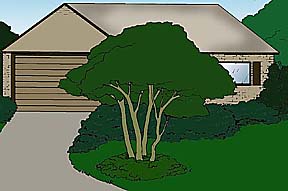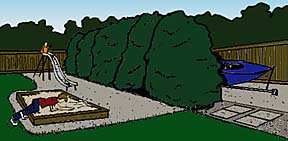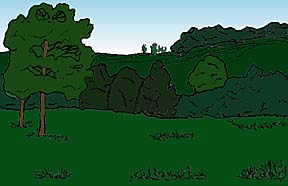Living trees, shrubs, vines, groundcovers, annuals and perennials are usually the most important materials in landscaping. Their selection, placement and maintenance are the main criteria the layman uses to evaluate landscape work. It is extremely important, therefore, to select plants that will serve the function as dependably as possible. For every landscape need there are numerous plants to choose from.

Native Plants
Native plants are rightfully gaining a prominent place in the landscape. Although we have seen an increase in planting and preserving native plant species, we are still a long way from maximizing their potential. Often the native plants are more resistant (tolerant) to drought, insects and disease. If species are selected that are native to the immediate vicinity of the home, there is an additional bonus of visually relating the new landscape to the natural environment.
Unusual challenges for landscaping with native plants can be found in some of our more densely populated areas. Subdivisions around Austin and San Antonio, for instance, are often located in hilly areas to take advantage of views. The ecology of these sites is very delicate with a thin soil layer over rock supporting a few small trees such as Texas persimmon (Diospyros texana), live oak (Quercus virginiana), agarita (Mahonia trifoliolata) and sumac (Rhus lanceolata).
If the property owner has a stereotyped concept that landscaping should consist of planting various broadleafed evergreen trees and flowering shrubs, he may clear the site of all the “brush”. Then, after spending considerable time and money trying to provide topsoil, irrigate adequately and reduce soil pH as well as deal with insect and disease problems, the property owner wonders why maintaining the landscape is such a big and expensive job.
With some careful thinning, pruning, transplanting and a few well-placed groundcover areas, the property owners could have an attractive and functional landscape. Builders, developers and homeowners need to evaluate natural growth on the site before destroying it.
Diverse temperatures, topography, soil and rainfall in Texas give every part of the state its own unique character. We can develop more functional and attractive home landscapes by utilizing native plants.
Much of the thinking about the use of native plants in the landscape has changed in recent years. Although these plant materials, in their native habitat, offer many of the benefits described above – these attributes are lost if the plants are not used properly in a landscape. Native plants use as much water, fertilizers and pesticides as non-natives if they are not managed in a “sustainable” manner. This requires a thorough understanding of the plant(s) and a willingness to accept some their short comings in the landscape.
There are many well adapted, non-native plants that can significantly limit environmental impacts in the landscape. These days, there is less concern about “plant origins” and greater emphasis on “resource efficiency”.
Use the Earth-Kind Plant Selector to find native and non-native plants that are HIGHLY ADAPTED to your specific location. Plants with an Earth-Kind Index of 8 or above are considered extremely resources efficient.
Plant Grouping

Plants are basically used as specimens, in lines, in groups or in masses. Each method creates a different effect. Most landscapes will use all four types of groupings.
Specimen or Accent

Using plants as specimens is a good way to emphasize a character shrub or an unusually beautiful tree. If used sparingly, accent plants create interest and contrast. Too many specimens, however, result in visual chaos. Flowering trees such as crape myrtles, dogwood and redbuds are often used for accent. Using a specimen plant or small tree near the entrance can help focalize on that area. Container plant specimens are another good possibility for accent if plants and container are scaled to the area.
Line

Lines of trees, shrubs and other plants can effectively carry the home’s architectural lines into the landscape. Straight or curved lines of tree plantings can shade parking or play areas or serve as a windbreak. Select hardy, well-adapted plants to form a line since the visual effect can be spoiled if one or a few of the plants are damaged. Also be sure that the same soil, drainage and sun conditions occur along the length of the row since any or all of these factors can significantly affect the plant.
Group

Grouping is a relatively natural way to use plants. Place several trees, shrubs, etc. fairly close together for a more massive effect. Since plants are often grouped naturally, this is a good method to relate your landscape to the natural environment. Also group container plants for emphasis.
Mass

The mass is really just an extension of the group. In mass plantings, individual plants tend to lose identity. Mass plantings are especially useful in relating large buildings to the site since these plantings can be large enough to be in good scale.

